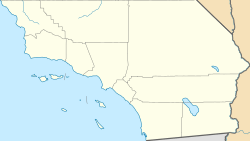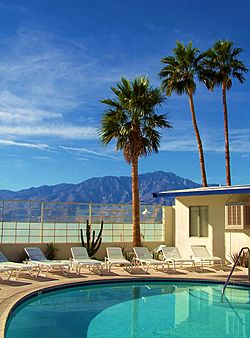Desert Hot Springs, California facts for kids
Quick facts for kids
Desert Hot Springs, California
|
|||
|---|---|---|---|
|
|||

Location of Desert Hot Springs in Riverside County, California.
|
|||
| Country | |||
| State | |||
| County | |||
| Incorporated | September 25, 1963 | ||
| Government | |||
| • Type | Council-Manager | ||
| Area | |||
| • Total | 30.66 sq mi (79.41 km2) | ||
| • Land | 30.27 sq mi (78.40 km2) | ||
| • Water | 0.39 sq mi (1.01 km2) 0.11% | ||
| Elevation | 1,076 ft (328 m) | ||
| Population
(2020)
|
|||
| • Total | 32,512 | ||
| • Density | 1,074.03/sq mi (414.68/km2) | ||
| Time zone | UTC-8 (Pacific) | ||
| • Summer (DST) | UTC-7 (PDT) | ||
| ZIP codes |
92240–92241
|
||
| Area codes | 442/760 | ||
| FIPS code | 06-18996 | ||
| GNIS feature IDs | 1656484, 2410328 | ||
Desert Hot Springs is a city in Riverside County, California, United States. It's located in the Coachella Valley. In 2020, about 32,512 people lived there. The city has grown a lot since the 1970s. People often call it DHS for short.
The city gets its name from its many natural hot springs. It's special because it has both hot and cold mineral springs. There are over 20 places in town where you can enjoy these natural springs. Unlike some hot springs, the ones here don't have a strong sulfur smell.
Contents
History of Desert Hot Springs
Early Settlers and Discoveries
The first person to claim land in the Desert Hot Springs area was Hilda Maude Gray in 1908. This was part of the Homestead Acts, which allowed people to settle on land.
Cabot Yerxa arrived in 1913. He soon found a hot water source on Miracle Hill. A major San Andreas Fault branch runs through the area. This fault causes one side to have cold water and the other to have hot water. Cabot built a large home over 20 years. This adobe-style building is now one of the oldest in Riverside County. It's called Cabot's Pueblo Museum and is a state historical site.
Founding and Growth of the City
L. W. Coffee founded the town on July 12, 1941. He chose the name Desert Hot Springs because of the natural hot springs. The original town was small, only one square mile.
In the 1950s, Desert Hot Springs became a popular tourist spot. Many small spa hotels opened. The city was especially popular with "snowbirds," who are people who move to warmer places for the winter.
The area grew as more people bought land. It officially became a city in 1963 with about 1,000 residents. The city continued to grow quickly in the 1980s and 1990s. Many new houses and apartments were built. By 2000, the population had increased by 5,000 people.
In 1993, a hotel called Mirage Springs Hotel Resort opened. It later became the Miracle Springs Resort and Spa. Desert Hot Springs High School opened its doors in 1999.
Geography and Climate
Where is Desert Hot Springs?
The city covers about 23.6 square miles (61.1 square kilometers). Most of this area is land, with a small amount of water.
Weather in Desert Hot Springs
Desert Hot Springs has a desert climate. This means it gets very little rain, less than six inches each year. Summers are very hot, with temperatures often going over 107°F (42°C) in July and August. Nights are still warm, usually between 78°F and 90°F (25-32°C).
Winters are mild and pleasant. Daytime temperatures are usually between 68°F and 82°F (20-28°C). Nighttime lows are between 50°F and 65°F (10-18°C). Sometimes, in summer, it can get even hotter, above 110°F (43°C).
| Climate data for Palm Springs Int'l Airport (1981–2010 normals) | |||||||||||||
|---|---|---|---|---|---|---|---|---|---|---|---|---|---|
| Month | Jan | Feb | Mar | Apr | May | Jun | Jul | Aug | Sep | Oct | Nov | Dec | Year |
| Record high °F (°C) | 95 (35) |
99 (37) |
104 (40) |
112 (44) |
116 (47) |
121 (49) |
123 (51) |
123 (51) |
121 (49) |
116 (47) |
102 (39) |
93 (34) |
123 (51) |
| Mean daily maximum °F (°C) | 65.0 (18.3) |
73.9 (23.3) |
80.5 (26.9) |
87.5 (30.8) |
95.6 (35.3) |
103.6 (39.8) |
108.1 (42.3) |
107.3 (41.8) |
101.7 (38.7) |
91.1 (32.8) |
78.4 (25.8) |
66.0 (18.9) |
88.2 (31.2) |
| Mean daily minimum °F (°C) | 35.0 (1.7) |
48.0 (8.9) |
52.2 (11.2) |
57.4 (14.1) |
64.4 (18.0) |
71.0 (21.7) |
77.6 (25.3) |
77.6 (25.3) |
71.7 (22.1) |
62.5 (16.9) |
50.0 (10.0) |
44.2 (6.8) |
59.3 (15.2) |
| Record low °F (°C) | 19 (−7) |
24 (−4) |
29 (−2) |
34 (1) |
36 (2) |
44 (7) |
54 (12) |
52 (11) |
46 (8) |
30 (−1) |
23 (−5) |
23 (−5) |
19 (−7) |
| Average precipitation inches (mm) | 1.15 (29) |
1.11 (28) |
0.53 (13) |
0.06 (1.5) |
0.02 (0.51) |
0.02 (0.51) |
0.13 (3.3) |
0.29 (7.4) |
0.23 (5.8) |
0.24 (6.1) |
0.32 (8.1) |
0.87 (22) |
4.97 (126) |
| Average precipitation days (≥ 0.01 in) | 3.1 | 3.2 | 1.6 | 0.6 | 0.2 | 0 | 0.6 | 0.9 | 0.8 | 0.7 | 0.8 | 1.9 | 14.4 |
| Source: NOAA | |||||||||||||
Unique Water Sources
The Mission Creek Fault, a part of the San Andreas Fault, divides two underground water sources called aquifers. On one side, the Desert Hot Springs area has an aquifer with hot water. This is where the city's famous spas get their warm mineral water.
On the other side of the fault, the Mission Springs area has a cold water aquifer. This aquifer provides fresh drinking water to the city. This water is known for its excellent taste and has even won awards!
Population and People
| Historical population | |||
|---|---|---|---|
| Census | Pop. | %± | |
| 1960 | 1,472 | — | |
| 1970 | 2,738 | 86.0% | |
| 1980 | 5,941 | 117.0% | |
| 1990 | 11,668 | 96.4% | |
| 2000 | 16,582 | 42.1% | |
| 2010 | 25,938 | 56.4% | |
| 2020 | 32,512 | 25.3% | |
| U.S. Decennial Census | |||
How Many People Live Here?
In 1941, only 20 people lived in Desert Hot Springs. By 2014, the population had grown to 28,000 residents. The 2010 United States Census counted 25,938 people living in the city.
Most people (99.5%) lived in homes, while a small number lived in group housing. The average household had about 3 people.
Diverse Community
Desert Hot Springs is home to a diverse group of people. Many residents have Mexican and Central American backgrounds. There is also a Korean American community. Thousands of American Jews have made the city their home.
The local National Association for the Advancement of Colored People (NAACP) says that over 10 percent of the city's population is African-American or Black. The city also has many Native Americans, especially members of the Cahuilla tribe.
Economy and Spas
Local Industries
Desert Hot Springs is known for its windmill farms in the west and near the San Gorgonio Pass. These windmills, along with growing solar power use, make Desert Hot Springs a leader in renewable energy.
The main part of the city's economy comes from its many spas. Most of these spas are owned and run by individuals or families. The warm climate and natural hot springs make the city a popular place for tourists to visit and relax.
Hot Mineral Water Spas
Desert Hot Springs is famous for its hot mineral water spas. In the 1950s and 1960s, there were over 80 spa hotels. Many of these smaller, unique hotels have been updated and reopened. Their mid-century modern style attracts visitors looking for a special spa experience.
Some well-known spa hotels in Desert Hot Springs include:
- The Miracle Springs Resort & Spa, which has been used as a filming location for movies like Mulholland Falls and Senior Moment.
- The Two Bunch Palms Resort, which was a filming location for the movie The Player in 1992.
- The Desert Hot Springs Hotel and Spa, which was featured on the TV show California's Gold in 2001.
Modern Architecture
At one time, there were 43 small spas in the city. Some were on Miracle Hill, where early settler Cabot Yerxa lived. His home is now Cabot's Pueblo Museum.
Miracle Manor Retreat, built in 1949, was one of the first spas. It was later restored to its original look. The Desert Hot Springs Motel, designed by famous architect John Lautner, is also nearby.
In 2006, an architecture company designed a special sustainable, modernist home in the city. This home was a test for building more eco-friendly, pre-made houses.
Education and Culture
Schools in the City
Most of Desert Hot Springs is part of the Palm Springs Unified School District. A small part of the city is in the Banning Unified School District. Desert Hot Springs High School opened in 1999 and serves students in the Palm Springs district.
Museums and Local News
- Museums: Cabot's Pueblo Museum is named after Cabot Yerxa, an early settler. It shows his unique home and collections.
- Local News: The Desert Star Weekly is a newspaper published in the city.
Wildlife Around Desert Hot Springs
Desert Hot Springs is located just south of large nature areas. These include Big Morongo Canyon Preserve and Joshua Tree National Park. The areas around the city are home to many animals that can live in the desert.
Some of these animals are pronghorns, desert bighorn sheep, desert tortoise, kit fox, desert iguana, horned lizard, chuckwalla, roadrunners, mountain lions, raptors, and Gila monsters. While not common, a black bear was even seen near the city in 2010!
Notable People
- John L. Gaunt, photographer
- Janet Gaynor, actress
- Gus Henderson, football coach
- Knute Hill, Democratic politician
- Paul Krassner, author, journalist, comedian
- Noel Langley, South African novelist
- Robert McAlmon, author
- Jerome Storm, film director
- Joan Woodbury, actress
- Rick Zumwalt, wrestler
Images for kids
See also
 In Spanish: Desert Hot Springs para niños
In Spanish: Desert Hot Springs para niños









